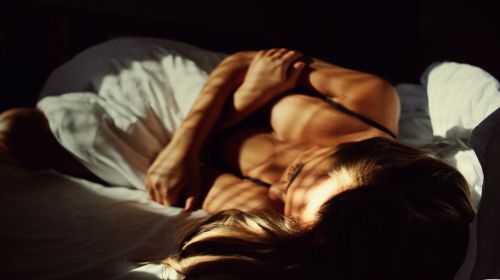Cold, wet and gray – the winter clouds the mood for many. The reason for the winter depression is lack of light. Symptoms and tips against winter blues and when treatment is necessary.
- Seasonal affective disorder often occurs in the cold and dark months of the year.
- © iStockphoto / chinaface
As its name suggests, winter depression occurs mainly in the dark winter months and is therefore also called seasonally dependent depression (SAD). In particular, residents of the temperate latitudes are affected, as the length of the day fluctuates considerably over the course of a year.
Article content at a glance:
What is winter depression?
In the cold season, there is an increase in depressive disorders of around ten percent. Women are affected significantly more often than men – mostly in the middle years of life. Seasonal Affective Disorder (SAD) is a mental illness with seasonal dependence. Medical professionals also speak of a recurrent depressive disorder, which occurs with a seasonal pattern.
In the northern hemisphere, seasonal depression generally begins in October / November and ends in March / April.
Winter depression occurs independently of psychosocial stressors and usually disappears completely. Around 13 percent of the population in Central Europe suffer from mild, four percent from severe SAD, according to a study by the University of Vienna.
Symptoms of winter depression
The typical signs of winter depression are similar to those of other depressive illnesses. Except for three differences: With SAD, those affected do not complain of sleep disorders, but of an increased need for sleep. Instead of loss of appetite, they very often develop an increased appetite, sometimes cravings for sweets and carbohydrates. They also gain weight instead of losing weight.
Other symptoms of winter depression are:
- persistent fatigue
- Listlessness
- physical exhaustion
- sadness
- Tendency to isolation
- Disinterestedness
- irritability
Depression or harmless winter blues?
Everyone should have already experienced in themselves that autumn and winter with shorter days or bad weather occasionally hit their spirits. With the autumn or winter blues, however, the gloomy mood usually disappears quickly.
-

Do you suspect that you are suffering from depression? Or are you worried about a loved one? The self-test brings more clarity.
to the test
In the case of SAD requiring treatment, however, these signs appear for at least two consecutive years for at least two weeks.
Cause: Disturbed melatonin and serotonin production
The cause of SAD is suspected to be, among other things, impaired melatonin and serotonin production in the brain, due to the lack of light in winter.
As early as September, the average sunshine duration in our latitudes drops considerably, in November the monthly sunshine duration in Germany with an average of almost 50 hours is only a quarter of the values from the summer months with almost 200 hours.
This has an impact on the body, because light affects the hormonal balance. When there is little light, the body produces fewer mood-enhancing endorphins and releases a smaller amount of the happiness hormone serotonin. At the same time, more melatonin is produced, which controls the sleep-wake cycle.
Experts assume that the sleep hormone melatonin is responsible for the bad mood. Due to the darkness, it cannot be broken down; the concentration of the substance in the brain increases. As a result, fatigue, dejection, and other symptoms can occur.
It is also discussed that the winter depression is triggered by the later sunrises in winter. This shifts the entire biorhythm compared to the time. Other medical professionals see winter depression as a holdover from hibernation and a protective mechanism of the body. It shuts down activities in the cold (and barren) season, lets us sleep more and put on weight to protect against the cold.
Risk factors for winter depression
Several factors can increase your risk of developing SAD. This includes:
- genetic predispositions
- gender
- Age
- professional and family situation
- current psychological stress
Treatment of winter depression
A persistent depression should be a reason to see a doctor, because a real SAD should always be treated. If you are not sure whether it is the more harmless variant of the winter blues or a winter depression that requires treatment, it is best to talk to your doctor. He will first rule out possible physical causes for the depressive symptoms such as vitamin deficiency or a thyroid disease through blood tests and, if necessary, refer the person concerned to a specialist.
Light therapy or phototherapy
Light therapy is the first choice in the treatment of seasonally dependent depressive disorders. It is mainly used for mild and moderate winter depression. The patient sits in front of a special light source for 15 minutes to two hours a day. The illuminance is important: the lamp must generate at least 2,500 lux in order to be effective. The treatment should take place in the morning, immediately after getting up, and should be carried out for at least three to four weeks. The length of a light session depends on the strength of the lamp: With a 2500 lux source, the daily treatment time is up to two hours, with a higher lux dose the time is reduced to 30 to 40 minutes. Unlike in the solarium, the person concerned has to look into the light with open eyes. The anti-depression lamps cannot tan, the UV light is filtered out.
Solarium is no alternative to light therapy
Light therapy does not mean the artificial sun in solariums, because the UV rays in the solarium must not get into the eyes. The production of melatonin is curbed by the light falling on the retina. The amount of visible light that is generated under the sunbed is nowhere near enough to be able to treat autumn / winter depression.
In contrast to phototherapy for skin diseases, the statutory health insurance companies do not cover the costs for light therapy for seasonal depression.
Medication
Depending on the severity of the winter depression, as with other depressive disorders, there are also serotonin reuptake inhibitors (SSRI) for use. Lighter forms can also be treated with herbal preparations, St. John's wort, for example, with St. John's wort.
What can be done against winter depression and winter blues?
The most important preventive as well as therapeutic measure against winter depression or the lighter version of winter blues is to get enough daylight regularly, even in the darker months of the year. The sun doesn't necessarily have to be shining. Even normal daylight when the sky is overcast is still fifty times stronger than an average room lighting at around 5,000 lux. 30 to 60 minutes a day in daylight is sufficient for a noticeable effect.
Walks are particularly suitable because you not only recharge your batteries with light and oxygen. Movement has also been shown to have a positive effect on the mood. Even people diagnosed with depression benefit from taking walks in the open air.
Little things in everyday life also ensure that the gloomy mood does not gain the upper hand. Everything that makes you happy helps the body to release more serotonin:
Fruit instead of sweets: If you have a craving for sweets, you prefer fruit instead of chocolate and other "hip gold". This keeps you healthy and prevents extra pounds, which in turn can depress your mind.
Smaller goals: Do not expect too much, either privately or at work. Those who set themselves small goals often have an exhilarating sense of achievement.
Conscious of something Do good: Go out, meet friends – it lifts the mood.
To go on vacation: If you have the opportunity, you can brighten up the cloudy season with a sun holiday by the sea or in the mountains.
Sex and caresses: Cuddling with your partner and having sex naturally also have a lightening effect on your mood.
Color show: Colorful outfits and colorful accessories put you in a better mood than black and gray clothes. Fresh flowers in the apartment can also lighten the mood.
Herbal Medicines: When the mood is low, St. John's wort can help to improve the mood. The medicinal plant must be taken for several weeks. However, it is advisable to seek the advice of a doctor or pharmacist, as the St. John's wort preparations available are of different quality, the correct dosage is important and interactions with other drugs are possible.



